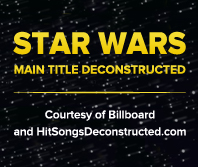-By Joe Lynch
The “Star Wars” logo seen in the opening of the films COURTESY OF LUCASFILM
Thank the maker — Star Wars returns to theaters and our lives this week with Star Wars: The Force Awakens. But really, did it ever leave? The film series’ iconic, epic main title has been playing in fans’ heads ever since A New Hope scrolled onto screens in 1977. Seriously, it’s impossible to think about Star Wars without the theme music bursting into your brain, and a sense of victory-against-the-odds swelling through your chest.
So why is that? We spoke with David Penn, founder and editor-in-chief of Hit Songs Deconstructed (an essential source for hit songwriting trends and analysis), for an expert musicologist’s look into why John Williams’ main title for Star Wars is one of the most successful (a disco version actually topped the Hot 100 for two weeks in 1977), identifiable and enduring movie themes of all-time.
According to Penn, the theme is “arguably the most recognizable and iconic theme in cinema history.” And that’s not simply a function of the film’s popularity bolstering the music. Comparing the main title to the top 10 of the Billboard Hot 100 during the third quarter of 2015, Penn discovered the theme shares many structural characteristics of a mainstream hit.
And while the same can be said of a few other movie themes in the post-George Lucas landscape (Williams’ film compositions in particular), the Star Wars main title is especially built to “reinforce the theme’s primary hook/payoff in the listener’s head.”
Using a breakdown of the Star Wars theme provided by Hit Songs Deconstructed, we’re digging into what makes Williams’ “Main Title” so readily identifiable and unforgettable.
Below is a graphic showing how Hit Songs Deconstructed broke the song into five parts for us (set against the Death Star). Under that, via some lightsaber action, there’s a graphic showing how the various sections of the Star Wars main title correspond to a hit pop song’s parts.
Star Wars main title graphic COURTESY OF BILLBOARD
For a deeper dive on the various sections of the song, read on.
Intro
Length: 0:00 – 0:08
Mood: Excitement
Primary Instruments: Brass
Like a mainstream hit, the intro clocks in close to 10 seconds. After the 20th Century Fox Fanfare, Star Wars opens with orchestral fanfare of its own that — even in 8 seconds — previews the film’s central storyline of this heroic (Luke), adventurous (Han) and regal (Leia) battle against a military foe.
A Section Part I
Length: 0:08 – 0:26
Mood: Heroic, Adventurous
Primary Instruments: Brass
Following the opening fanfare of the intro, the Star Wars main title heads directly into the A section, its equivalent of a chorus. This is similar to how mainstream hits increasingly forgo a verse before the first chorus. According to Penn, the K.I.S.S. Principal (Keep It Simple and Singable) that works in pop choruses applies to the Star Wars main title’s A section (only in this case “keep it hummable” is more appropriate).
In the A section, rhythmic and melodic repetition abounds, with each independent melodic segment being short enough (4 to 5 notes) to encourage immediate impact and memorability. Additionally, hit songs employ what Penn calls “clever WOW factors” that accentuate the melody and make the song more memorable. The Star Wars theme has two in the A section:
1) Melodic Leaps
Prior to the brass instruments hitting those massive notes of victory, the melody descends down the scale for a few notes — so when it reaches the high notes, we notice a “pronounced sense of heroism through strong melodic leaps.”
2) Coming Together
At the end of each melodic phrase, the orchestra unites to play the final notes together, emphasizing “a grand sense of power” as each instrument joins forces. This ties into the movie’s theme of suddenly coming back together (i.e., Han Solo returning to help Luke on the Death Star run) to achieve great goals.
B Section
Length: 0:26 – 0:40
Mood: Compassionate
Primary Instruments: Strings
The B section, like the bridge to a mainstream pop hit, switches up the feeling and pace of the theme. The heroic brass punctuations of the A section are replaced by sentimental, compassionate strings in the B section. There’s more notes here and they last longer, which provides a rhythmic variance from the quick-paced A/chorus section. Even within this section, repetition occurs to maximize hummability.
C Section
Length: 0:40 – 0:48
Mood: Excitement
Primary Instruments: Brass and strings
Like the pre-chorus that ushers in the return of a chorus in a mainstream hit (78 percent of top 10 hits in the third quarter had a pre-chorus), the C section of the Star Wars main title serves to “ramp up the excitement factor via fanfare/brass instrumentation.” Unlike the opening intro fanfare, this also features strings, providing consistency from the B section to the return of the A section.
A Section Part II
Length: 0:48 – 1:06
Mood: Heroic, Compassionate, Victorious
Primary Instruments: Brass and strings
When the A section returns to close out the main title, it’s similar to the final chorus in a pop song: The melody repeats, but with the energy level at a new peak.
Also, the background instrumentation is changed up to provide additional interest. In the case of Star Wars, this means not only does the brass of the A Section I return, but strings carry over from the B and C sections, melding the heroic mood with the compassionate tone of the B section.
In terms of additional instrumentation to add aural interest, Penn points out that “rapid-fire trumpets enter the mix during the second half, which add an air of triumph and victory, bringing the listener to an excited high before the main title fades out, segueing into whatever (typically quieter) music opens the film.


